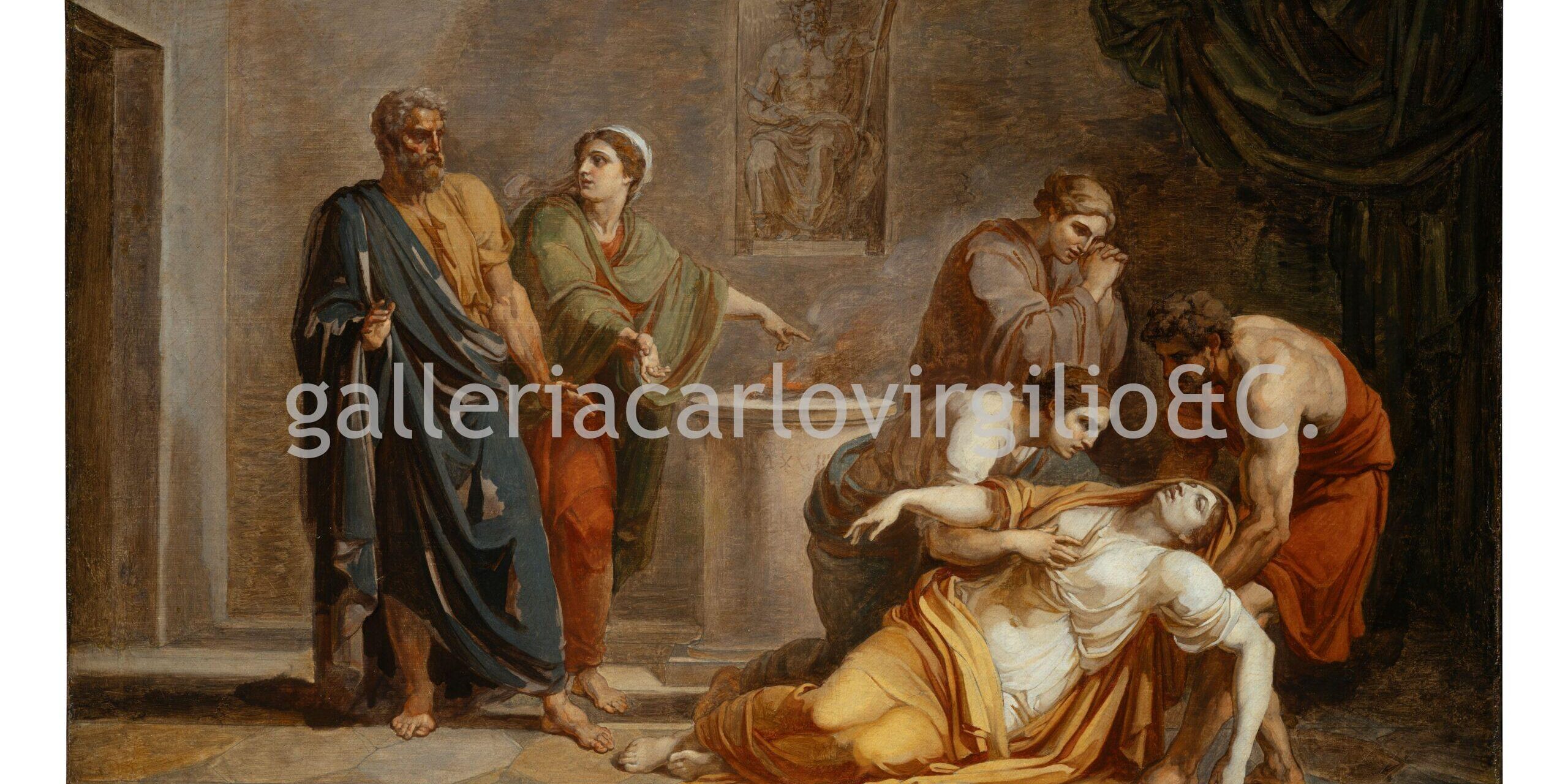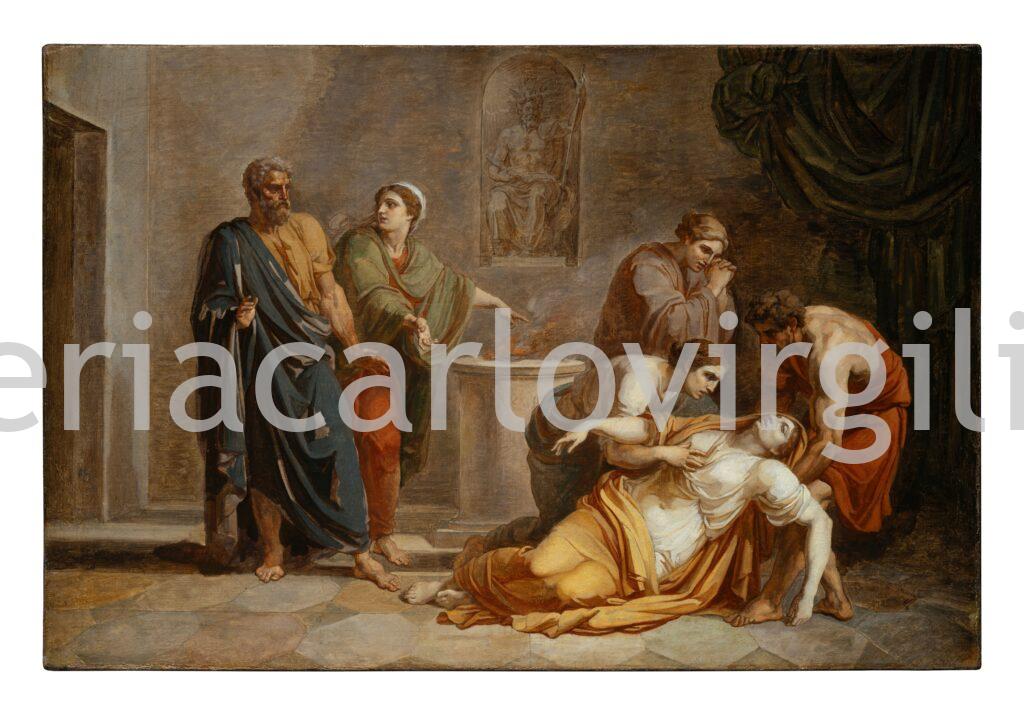| AVAILABLE

Vincenzo Camuccini
Rome 1771 – 1844
The Death of Porzia • 1824 ca.
Oil on canvas, 42.5 x 64.5 cm
The episode portrayed in this sketch by Vincenzo Camuccini is taken from the history of Rome in the Republican era, an inexhaustible reservoir of exemplary acts of civil and moral virtue, to which painters in neo-classical times, and especially Camuccini, turned to with great frequency.
The tragic event is narrated by numerous ancient sources, in particular by two historians from the Augustan age, Valerius Maximus and Nicolaus of Damascus (Rohr Vio 1998, p. 94), and later taken up by Shakespeare in Julius Caesar: Portia, daughter of Cato Uticensis, a woman known for her courage and steadfast character, receives the news of the death of her husband Marcus Junius Brutus at the Battle of Philippi (42 BC), eluding the vigilance of her friends and servants, who fear her reaction, she takes her own life by swallowing burning coals from a brazier. Worthy daughter of the incorruptible Cato, Portia represents an archetypal model of Roman virtue interpreted in the female. Her strength of spirit and conjugal loyalty are attested by a further episode narrated by sources and often portrayed by artists: kept in the dark by her husband about the plots he was weaving to bring about Julius Caesar’s death, Portia inflicted a serious wound to her thigh in order to demonstrate her bravery to Brutus and her ability to suffer physical pain, and hence to be worthy of participation in the tyrannicidal plans. However, Portia’s suicide note, according to an interpretation established in antiquity, has connotations of a political choice, in that the defeat at Philippi, in which Portia also lost her brother, marked the end of the Republican cause for which Brutus had conspired against Caesar (Rohr Vio 1998, pp. 95-96).
The sketch presented here, unpublished, is the only painting version known today of a creation by Camuccini until then only known of through pen and pencil sketches and drawings, all dating back to the artist’s mature years (1820s), although hard to date with precision. Two drawings and a sketch in pen, originating from the artist’s atelier estate, kept almost intact by the heirs until the 1980s, were published in the catalogue of the monograph exhibition of 1978 (Piantoni 1978, n. 135, p. 65, n. 4; nn. 137-138, pp. 66-67). A further, sizeable sketch, with watercolouring, and highlighted in lead white, also from the artist’s estate, was bought in 2006 by the National Gallery of Canada (described in Verdone 2005, n. 18, pp. 70-71, but misrepresented in interpretation). The sketches published by Gianna Piantoni (Piantoni 1978, p. 66) come closest to ours, from which they differ, besides for the greater development of the background, in the poses of some of the figures, in particular the man on the left who is different in all the preparatory versions of the subject. However, the Ottawa sketch does have more figures with respect to the other versions and is richer in background and furnishings.
On the other hand, the full size canvas that would represent the outcome of all this preparatory material has not been found, although carefully entered by Camuccini in his lists of the works produced over the course of his activity, with an indication as painted for “a Russian, now [i.e. in 1833] in Ravenna” (Piantoni 1978, p. 66; Hiesinger 1978, p. 317, n. 51). Also appearing on the lists, among the “Drawings on commission” is a “Death of Portia for Count Apponi” (Piantoni 1978, p. 101, n. 8), payment 60 scudi (Hiesinger, p. 319). Both the “Russian,” and the Hungarian count Apponyi, quite likely Antal Rudolph, Habsburg ambassador to Rome from 1820 to 1826, represent very well the international nature of Camuccini’s clientele in the Rome of the Restoration. Moreover, the dates of Apponyi’s stay in Rome contribute to dating the sketch, and in general, to Camuccini’s activity on the theme of Portia.
There is also clear evidence of our sketch to be found in Camuccini’s written lists: in fact it is highly probable that it should be identified as the “Sketch by my hand for Baruzzi of the Death of Portia,” inserted in the long list of works entitled “Year 2024,” containing the works made from that date onwards (Piantoni De Angelis 1978, p. ). The position on the list suggests that it was painted toward the end of the twenties, certainly before 1831, when the recipient of the canvas definitively left the city of Rome. Furthermore, the Baruzzi for whom Camuccini makes the sketch must be the sculptor from Imola, Cincinnato Baruzzi, resident in Rome from 1817 to 1831, close collaborator of Canova, whose unfinished works he completed at the death of the maestro in 1822, taking on the direction and later ownership of the famous atelier in via delle Colonnette (Mampieri 2014, p. 18, 21-27). It is not clear whether the sketch was commissioned by Baruzzi, as one would suppose from the note on the list, and in that case it might have been a d’après, explicitly defined “by my hand,” of the painting made for the unknown Russian client; or if it is a preparatory sketch of the large canvas, sold at a certain point to the Bolognese sculptor, who in the course of his life had gathered an important collection of contemporary works of art, for the most part dispersed and damaged during the Austrian occupation of Bologna in 1849. On that occasion, Baruzzi lamented the loss of many important works of art, several of them gifts from artist friends, such as Canova, and among them, paintings by Camuccini (Sighinolfi [1943] 2007, p. 335).
The effortless and confident craftsmanship – that “virginity of the maestro’s tone” that Cicognara appreciated in Camuccini’s sketches (Falconieri 1875, p. 264) – and the unfinished blue mantel of the figure on the left might make one lean towards a preparatory phase; in which case the date should go back a few years, whilst still in the third decade of the century. In any event, the very high quality of the painting, even in comparison with other sketches by Camuccini, finds full confirmation in the wording “by my hand” recorded by the painter on his list. The picture is in the most characteristic style of the Roman painter: from a technical point of view, we can admire the completeness of the design, drawn in pencil, quite visible under the colour, particularly in the architectonic profiles; the application of colour in brief, decisive brushstrokes, which let the preparation show through transparently in the background, while in the figures they are diluted to produce sculptural modelling, enhanced by the chiaroscuro; the prevalent grey brown tonality is animated by the patches of colour in the figures’ clothes. From a compositional point of view, the Death of Portia repeats a familiar scenography in Camuccini, based on a well-balanced arrangement of the figures, carefully distributed into two groups, within an architectonic enclosure bordered by a sparing architectural backdrop, suited to the Republican era in which the narrative takes place. In such a defined space, the figures – in an orchestrated emphasis of gestures and expressions characteristic of the painter – express their dismay at Portia’s extreme action, as she falls with noble grace into a pose not very different to that adopted years before by Camuccini in the Death of Virginia.
As a whole, this is an emblematic work by one of the greatest protagonists of the artistic production in Rome in the early decades of the nineteenth century.
The painting is on the original canvas, with original structure and frame, and in an almost perfect state of conservation.
Federica Giacomini
BIBLIOGRAPHY
Falconieri 1875
Falconieri, Vita di Vincenzo Camuccini e pochi studi sulla pittura contemporanea, Rome 1875
Piantoni 1978
Vincenzo Camuccini 1771-1844. Disegni e bozzetti dallo studio dell’artista, cat. mostra a cura di G. Piantoni De Angelis (Roma, Galleria Nazionale d’Arte Moderna, 27 ottobre – 31 dicembre 1978), Rome 1978
Hiesinger 1978
Hiesinger, The paintings of Vincenzo Camuccini, in “Art Bulletin”, LX/2, June 1978, pp. 297-320
Rohr Vio 1998
Francesca Rohr Vio, Strategie autocensorie e propaganda augustea: la morte di Servilia nel racconto di Velleio, in Temi augustei, Atti dell’incontro di studio Venezia, 5 giugno 1996, a cura di G. Cresci Marrone, Amsterdam 1998, pp. 93-98
Sighinolfi [1943] 2007
Lino Sighinolfi, La vita e le opere di Cincinnato Baruzzi, in Uno scultore neoclassico a Bologna fra Restaurazione e Risorgimento. Il fondo Cincinnato Baruzzi nella Biblioteca dell’Archiginnasio (1943), a cura di C. Maldini, Bologna 2007, pp. 302-354
Mampieri 2014
Antonella Mampieri, Cincinnato Baruzzi (1796-1878), Bologna 2014
For further information, to buy or sell works by Camuccini Vincenzo (1771-1844) or to request free estimates and evaluations
mail info@carlovirgilio.co.uk
whatsapp +39 3382427650
